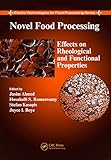Novel Food Processing. Effects on Rheological and Functional Properties
Language: Eng Series: Electro-Technologies for food processingPublication details: Boca Raton Taylor & Francis 2010Description: xvii, 491 páginas; Imágenes, Gráficos, Tablas; 25 cmISBN:- 9781420071191
- 664.02 AH286
| Item type | Current library | Call number | Copy number | Status | Date due | Barcode | |
|---|---|---|---|---|---|---|---|
 Libros
Libros
|
CIBESPAM-MFL | 664.02 / AH286 (Browse shelf(Opens below)) | Ej: 1 | Available | 002782 |
Browsing CIBESPAM-MFL shelves Close shelf browser (Hides shelf browser)

|

|

|

|

|

|

|
||
| 664.001579 / M913 Microbiología de los alimentos. | 664.00286 / W246 Tratamiento de los residuos de la industria del procesado de alimentos. | 664.00286 / W246 Tratamiento de los residuos de la industria del procesado de alimentos. | 664.02 / AH286 Novel Food Processing. | 664.02 / AL472 Principios de ingeniería aplicados en alimentos. | 664.02 / C435 Postharvest technology and food process engineering. | 664.02 / F322 Tecnología del procesado de los alimentos. |
Chapter 1. Introduction and Plan of the Book, J. Ahmed, H.S. Ramaswamy, S. Kasapis, and J.I. Boye
Chapter 2. Effect of Radio-Frequency Heating on Food, V. Orsat
Chapter 3. Ohmic Heating Effects on Rheological and Functional Properties of Foods, M. Marcotte, H.S. Ramaswamy, Y. Karimi-Zindashty, and M.R. Zareifard
Chapter 4. Effect of High Electric Field on Food Processing, A. Muthukumaran, V. Orsat, T.R. Bajgai, and G.S. V. Raghavan
Chapter 5. Pulsed Electric Fields: A Review on Design, S. Alkhafaji and M. Farid
Chapter 6. Ultrasound Effect on Food Processing, J. Salazar, J.A. Chávez, A. Turó, and M.J. García-Hernández
Chapter 7. Ultrasound Processing: Rheological and Functional Properties of Food, K. Muthukumarappan, B.K. Tiwari, C.P. O’Donnell, and P.J. Cullen
Chapter 8. Effect of Irradiation on Food Texture and Rheology, P. Bhattacharjee and R.S. Singhal
Chapter 9. Ozone and CO2 Processing: Rheological and Functional Properties of Food, K. Muthukumarappan, B.K. Tiwari, C.P. O’Donnell, and P.J. Cullen
Chapter 10. Gelation and Thickening with Globular Proteins at Low Temperatures, R. Mercade-Prieto and S. Gunasekaran
Chapter 11. Fundamental Considerations in the Comparison between Thermal and Nonthermal Characterization of Biological Glasses, S. Kasapis
Chapter 12. Effect of High-Pressure and Ultrasonic Processing of Foods on Rheological Properties, J. Tattiyakul and M.A. Rao
Chapter 13. Effect of High Pressure on Structural and Rheological Properties of Cereals and Legume Proteins, J. Ahmed
Chapter 14. High-Pressure Treatment Effects on Food Proteins of Animal Origin, P.A. Alvarez, H.S. Ramaswamy, and A.A. Ismail
Chapter 15. Functional Properties and Microstructure of High-Pressure-Processed Starches and Starch-Water Suspensions, Y. Liu, W. Zhou and D. Young
Chapter 16. Effect of High Pressure on Textural and Microstructural Properties of Fruits and Vegetables, N.K. Rastogi
Chapter 17. Pressure-Shift Freezing Effects on Texture and Microstructure of Foods, S. Zhu and H.S. Ramaswamy
Chapter 18. Issues and Methods in Consumer-Led Development of Foods Processed by Innovative Technologies, A.V. Cardello and A.O. Wright
Chapter 19. Novel Techniques for the Processing of Soybeans, J.I. Boye and S.H. Rajamohamed
Chapter 20. Supercritical Fluid Extrusion: A Novel Method for Producing Microcellular Structures in Starch-Based Matrices, S. Alavi and S.S.H. Rizvi
Chapter 21. Rheological Properties of Liquid Foods Processed in a Continuous-Flow High-Pressure Throttling System, R.K. Singh and L. Sivanandan
Chapter 22. Food Frying: Modifying the Functional Properties of Batters, M. Ngadi and J. Xue
Chapter 23. Allergenicity of Food and Impact of Processing, A. Lopata
Index
Rapid expansion of research on the development of novel food processes in the past decade has resulted in novel processes drawn from fields outside the traditional parameters of food processing. Providing a wealth of new knowledge, Novel Food Processing: Effects on Rheological and Functional Properties covers structural and functional changes at the micro level, and their implications at the macro level, in food exposed to new and emerging technologies.
Contributions from an international panel with academic and professional credentials form the backbone of this work. They focus on the functional, rheological, and micro-structural changes that occur in foods when using emerging technologies such as high pressure processing, Ohmic heating, pulse electric fields, and ultraviolet radiation. The book examines new and innovative applications and presents the impact of these research findings on the nutritional aspects of protein and carbohydrate containing foods. It also considers the synergic effects of protein-starch components. Each chapter provides an in-depth analysis of a novel technology and its effect on food structure and function.
New directions in food processing will continue to be influenced by diverse fields and used to respond to consumer concerns about food safety, quality, sensory attributes, and nutrition. Combining coverage of technological applications with the chemistry of food and biomaterials, this book illustrates in a very clear and concise fashion the structure-functionality relationship and how it is affected by newly developed and increasingly popular processing technologies.
There are no comments on this title.
